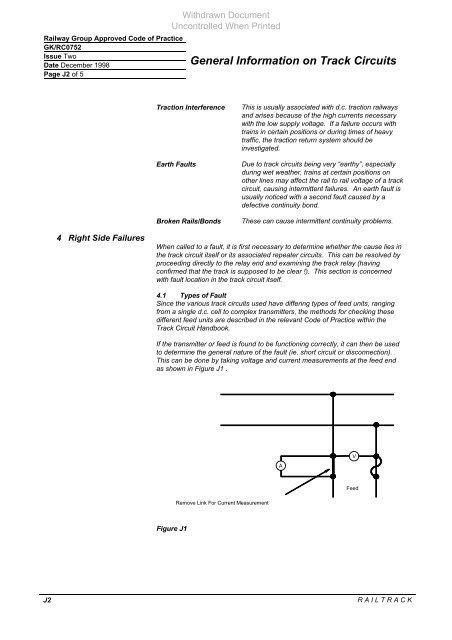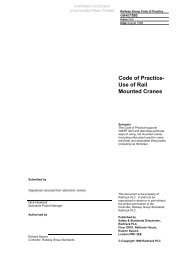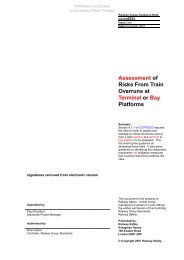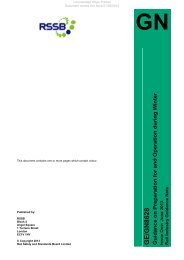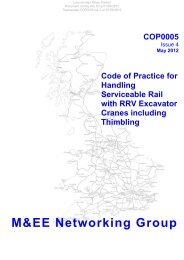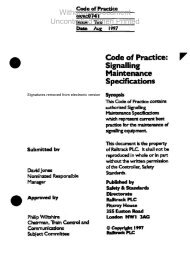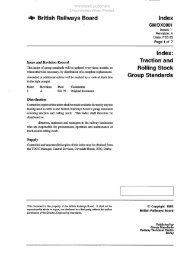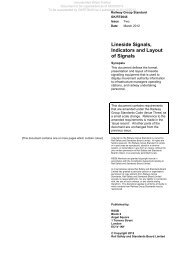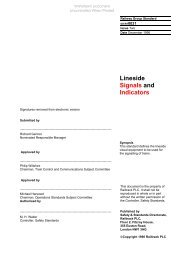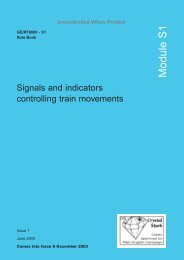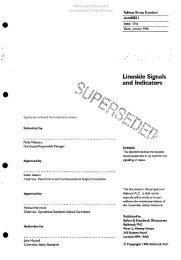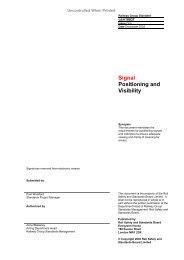General Information on Track Circuits - RGS Online
General Information on Track Circuits - RGS Online
General Information on Track Circuits - RGS Online
Create successful ePaper yourself
Turn your PDF publications into a flip-book with our unique Google optimized e-Paper software.
Railway Group Approved Code of Practice<br />
GK/RC0752<br />
Issue Two<br />
Date December 1998<br />
Page J2 of 5<br />
Withdrawn Document<br />
Unc<strong>on</strong>trolled When Printed<br />
<str<strong>on</strong>g>General</str<strong>on</strong>g> <str<strong>on</strong>g>Informati<strong>on</strong></str<strong>on</strong>g> <strong>on</strong> <strong>Track</strong> <strong>Circuits</strong><br />
Tracti<strong>on</strong> Interference This is usually associated with d.c. tracti<strong>on</strong> railways<br />
and arises because of the high currents necessary<br />
with the low supply voltage. If a failure occurs with<br />
trains in certain positi<strong>on</strong>s or during times of heavy<br />
traffic, the tracti<strong>on</strong> return system should be<br />
investigated.<br />
Earth Faults Due to track circuits being very “earthy”, especially<br />
during wet weather, trains at certain positi<strong>on</strong>s <strong>on</strong><br />
other lines may affect the rail to rail voltage of a track<br />
circuit, causing intermittent failures. An earth fault is<br />
usually noticed with a sec<strong>on</strong>d fault caused by a<br />
defective c<strong>on</strong>tinuity b<strong>on</strong>d.<br />
Broken Rails/B<strong>on</strong>ds These can cause intermittent c<strong>on</strong>tinuity problems.<br />
4 Right Side Failures When called to a fault, it is first necessary to determine whether the cause lies in<br />
the track circuit itself or its associated repeater circuits. This can be resolved by<br />
proceeding directly to the relay end and examining the track relay (having<br />
c<strong>on</strong>firmed that the track is supposed to be clear !). This secti<strong>on</strong> is c<strong>on</strong>cerned<br />
with fault locati<strong>on</strong> in the track circuit itself.<br />
4.1 Types of Fault<br />
Since the various track circuits used have differing types of feed units, ranging<br />
from a single d.c. cell to complex transmitters, the methods for checking these<br />
different feed units are described in the relevant Code of Practice within the<br />
<strong>Track</strong> Circuit Handbook.<br />
If the transmitter or feed is found to be functi<strong>on</strong>ing correctly, it can then be used<br />
to determine the general nature of the fault (ie. short circuit or disc<strong>on</strong>necti<strong>on</strong>).<br />
This can be d<strong>on</strong>e by taking voltage and current measurements at the feed end<br />
as shown in Figure J1 .<br />
Figure J1<br />
Remove Link For Current Measurement<br />
J2 R A I L T R A C K<br />
A<br />
V<br />
Feed


